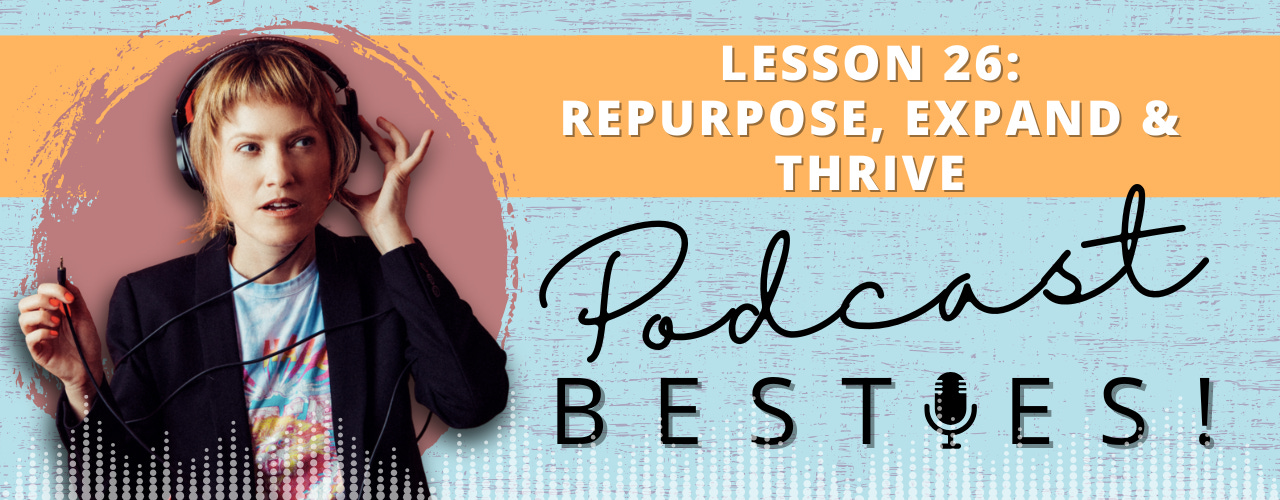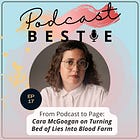Lesson 26: Expanding Your Podcast’s Reach
Adapting your show beyond the mic
Hey Besties!
OMFG—we’re on our 26th and final lesson! We’ll recap next week, but for now, relish the fact that we just spent six months upleveling our podcasting game together. And trust me, this last lesson is a goodie.
By now, you’ve got a podcast. You’re cranking out episodes, having meaningful conversations, and building a loyal listener base. Amazing work! But here’s the thing: if you’re only publishing in audio form, you’re leaving listeners, opportunities, and money on the table.
The good news? Your podcast isn’t just a podcast. It’s a content engine that can fuel books, articles, newsletters, radio stories, TV shows, and more. By adapting your work into other mediums, you can reach new audiences, expand your influence, create more ways to scratch your creative itch, and maybe even get your podcast to pay you back.
Let’s talk about how to take your content further, especially when it comes to repurposing episodes and pitching radio stories.
Iterate like an expert
Your podcast isn’t just an audio file—it’s an idea factory. Every episode you create is raw material that can be reshaped and remixed into something new. Here are some powerful ways to extend the life of your content:
✍️ Essays & articles: A single episode can spark a thoughtful personal or reported essay. Think of it as zooming in on one moment, theme, or question from your show and giving it room to breathe on the page. Essays are perfect for literary journals, anthologies, mainstream publications, or even as stepping stones toward a larger book project.
Some bylines related to my podcast, Private Parts Unknown:
LA Is Home to the Country’s Only Unionized Strippers — Here’s How They Did It
North Hollywood’s Star Garden reopens as only unionized strip club in nation
My OnlyFans Was a Fun Way for Me to Make Money. Then My Content Got Stolen.
📚 Books: If you’ve explored a niche topic in-depth or interviewed fascinating people around a theme, you may already have the building blocks of a book. I can think of countless examples: My Favorite Murder became the bestselling memoir Stay Sexy & Don’t Get Murdered. Cara McGoogan’s reporting for the second season of Bed of Lies inspired her book Blood Farm. My friend
adapted his Write About Now podcast into Write About Now, the book! Similarly, your audio archive could be your first draft.📝 Blogs & newsletters: Some people never listen to podcasts (tragic, I know!), but they do read blogs, essays, and Substacks. Repurposing episodes into written posts not only makes your work discoverable via search engines but also cements you as a thought leader in your niche by helping you connect with another audience segment.
’s Sound Judgment is a great example of how to give your podcast a new life as a newsletter. I also do a lot of that over on The Bleeders.📺 TV & film pitches: Podcasts are the new Hollywood scouting grounds. Dirty John, The Dropout, and Dr. Death all started as podcasts before landing on the screen. If your show has a strong central narrative or a world of rich characters, think about packaging it for a film or TV pitch, or writing the pilot or screenplay yourself.
📻 Radio stories: Radio is a natural cousin to podcasting. A compelling podcast miniseries can often be reshaped into a radio pitch (or vice versa). Try local NPR affiliates, This American Life, Snap Judgment, The Moth, or your favorite radio show. Many outlets look for compelling human-interest stories—and guess what? You’re already making them!
Here’s one I produced for KCRW that found a second life on my podcast:
Happily leather after at The Eagle in Silver Lake
Pitch radio stories like a pro
Not all podcasts translate directly to radio, but if you’ve got a narrative-driven episode, a gripping interview, a high-stakes personal story, or you’re documenting a recent trend, you might have a winner.
Here’s how to make the leap:
🎤 Pick your best story: Think: Why this, why now? Does it speak to a news development, current trend, or have topical relevance to the show you’re pitching? Look for strong characters, high emotional stakes, or a satisfying arc. What would grab someone in the first 30 seconds?
📩 Know where to pitch: Research outlets and programs that align with your podcast’s vibe. Each has its own flavor. This American Life loves stories that reveal something surprising about human nature. Snap Judgment is all about “storytelling with a beat.” The Moth thrives on live storytelling of first-person narratives. Look up their submission guidelines and tailor your pitch accordingly.
📝 Craft a killer pitch: Keep it short, sharp, and irresistible. What’s the heart of the story? Why does it matter right now? How will it sound on air? If you can answer those three questions, you’re ahead of the game.
📢 Be flexible: Radio often demands a tighter structure and additional narration. Be ready to work with an editor and adapt your podcast episode into a radio-first format. The more collaborative you are, the better your chances of repeat assignments.
The bottom line? Think bigger!
Your podcast is more than just a podcast—it’s a content goldmine.
The key to growth and getting your name out there is learning how to leverage your existing work into new opportunities. By repackaging your content, you create multiple entry points for people to find you, engage with you, and potentially pay you.
So don’t just make a podcast—make a content ecosystem. That’s how you grow your audience, boost your credibility, and open doors you didn’t even know were there.
I’m teaching some upcoming workshops you might be interested in:
Back to School Pitch Party (Use code BESTIE for $100 off)
How to Build a “Platform” for Writers Who Shudder at the Thought
Start a Newsletter to Supercharge Your Platform, Network and Business
Podcasting for Writers: How to Start, Sustain & Grow Your Podcast
So… ROLL CALL! 🗣
Have you ever adapted your podcast into another format? Comment below and let me know!





Great ideas! My first book was a compilation of my favorite blog posts, and my podcast began as a local radio show with sponsors.
Thanks for the mention, Courtney, and a great list of ideas for using your podcast as a flywheel for other content! In my mind, this is the only way to go these days - it’s strategic and essential.